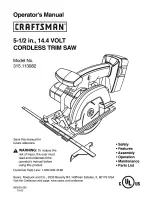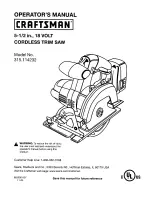
11
ENGLISH
Device used to feed the work-piece through the saw during
narrow ripping cuts. The push stick (13) helps to keep the
operator’s hands well away from the blade. Use the push
stick for ripping widths less than 6” (150 mm) and more than
2” (50 mm).
Changing the saw blade
Always unplug the saw from the power source before
maintenance to avoid risk of serious personal injury.
To remove the blade:
1. Remove the blade guard and the blade throat plate
(See Fig. U).
2. Raise the blade to the highest possible position.
3. To keep the arbor from rotating, place one of the
spanners on the flange flats.
4. Place the second spanner on the arbor nut.
5. Turn the second spanner clockwise to tighten,
counterclockwise to loosen. Loosen and remove the
arbor nut. (See Fig. V).
6. Remove the flange and pull the blade off the motor
shaft.
7. To install the blade, reverse the procedure.
Important! Blade rotation is clockwise when observing
from the right side of the saw. Make sure the rotation direc-
U
Blade throat
plate
V
Rip fence (see Fig. Q)
This rip fence is used for all ripping operations. Never rip
freehand without the fence in place and securely locked.
M
iter gauge (see Fig. R, S)
The miter gauge
(5) is used for performing cross cuts and
miter cuts. The gauge head is locked in the desired position
by tightening the lock knob. Always ensure the lock knob is
securely fastened before starting a cut. To adjust the miter
gauge angle, loosen miter gauge lock handle and rotate the
miter gauge body so that the “0” mark on the end of the sliding
bar points to desired position. Then tighten the lock handle.
Note: The miter gauge body has marks at 5-degree
increments. The sliding bar has marks at 1-degree
increments. Read both to get an accurate angle degree.
To adjust the miter gauge fence, loosen the lock knob
and slide the fence to the desired position. Then tighten
the lock knob.
Push stick (see Fig. T)
Sliding
bar
Lock knob
R
Lock
handle
Fence
S
T
Q
Summary of Contents for STST1825
Page 1: ...STST1825 English Original Instruction 3 14...
Page 2: ...FIG A 11 1 2 3 4 5 6 12 13 10 9 8 7...
Page 18: ...18 4 B5 5 4 B6 C1 C2 4 4 4 b D1 D3 3 2 D1 D2 0 2 2 f 5 1 4 B5 B6 D1 D2 3 2 1 C1 b b C2...
Page 19: ...19 D3 2 c 2 d 1 8 3 2 c 2 c F1 F2 3 1 0 2 1 D2 3 F1 1 3 2 3 3 4 G2 H1 H2 F1 G1 G2 H1 D3 c d F2...
Page 20: ...20 2 1 J1 3 J2 2 J3 4 90 90 2 90 K1 5 0 0 K2 H3 H4 1 9 I H3 I J1 J2 J3 H2...
Page 21: ...21 ON L M OFF N 10 O P 3 2 M O P K2 L N K1...
Page 22: ...22 T 13 6 150 2 50 1 U 2 3 4 2 5 2 V 6 7 U V Q R S 5 0 5 1 R S T Q...
Page 24: ...24 1 2 3 4 5 1 8 3 1 4 6 6 7 8 9 10 2 2 1 1 1 STANLEY Z...










































